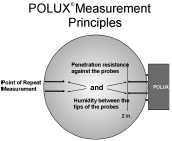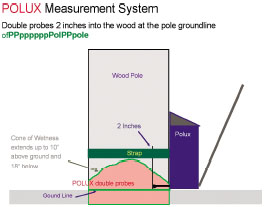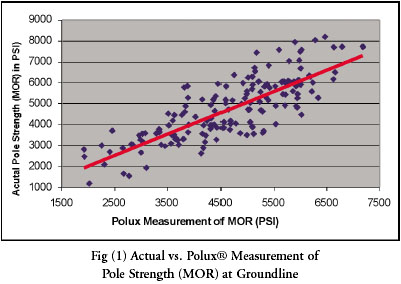Electric and Communications utilities in North America own upwards of 150 million wood pole structures. Inspecting and treating these poles in a timely manner is essential to maintaining system integrity and getting the most service life from this infrastructure. For most utilities, loading of in-service poles has increased as more cables and attachments for cable TV and Optical communications were added. At the same time more violent storms call into question older design and safety criteria that were used to design existing wood pole lines.
Wood remains the material of choice for use in poles because of its many inherent advantages and environmental acceptability. From the utilities’ perspective, poles made of wood are the most economical to install and maintain when compared to all other materials over a forty or fifty year cycle. Current subjective inspection and grading of poles by suppliers places the utilities in the position of buying a product that has no guarantee of performance nor a reliable strength value. The lack of reliable nondestructive evaluation (NDE) instrument to measure the strength of wood poles has resulted in limited knowledge of the condition of the pole when installed or when in service.
Like any other material, wood is vulnerable to the environment and can start deteriorating soon after installation, despite preservative treatment. Decay of wood structures most often occurs at the ground level where decay organisms are active in the presence of moisture, oxygen, food supply (wood), and temperature (20º to 30º Celsius). This zone extends from a few inches above ground to 18 in below. Statistics show that 95 % of pole breaks occur at the ground line.
Pole Structure Strength
A wood pole is not a homogeneous mass of fibers but a composite structure formed naturally from longitudinal wood fibers. Its strength is due to many variables of which growth rings and their number per inch of circumference is the most important. Hence the circumference of the pole and a physical measure of the wood fiber density is crucial in arriving at an estimate for the strength of the pole. Within this composite wood structure knots are present where tree branches grew. These knots can influence the strength of the structure depending on their size and on the species of wood. The whole structure has also water present in various degrees depending on the age of the wood and its location in the soil. This water is either present due to the remaining sap of the tree or is there from biodegradation of the wood.
Any reliable estimate of the strength of a wood pole must therefore take as many of the variables that influence the wood structure strength into consideration as is practical.
Effect of Decay on Pole Strength
In general, wood poles have not been found to lose strength from factors other than biodegradation (decay) or physical damage. Decay that destroys the outer shell of a pole rapidly reduces the bending strength. A 13% reduction in circumference caused by decay reduces the bending strength by 34%. Conversely, the impact on bending strength from internal decay is much less. For example, typical distribution sized poles that are hollow except for 2 inches of sound shell will theoretically retain 80% to 90% of their original bending strength. The magnitude of reduction in bending strength due to internal decay is much less than from shell rot. Consequently, measurement of fiber stress in the outer shell is a major factor to consider when evaluating currently available instruments for wood pole inspection.
Another factor to be evaluated along with the wood fiber stress is the moisture content and age of the wood. Moisture content is initially high when the pole is new and decreases during the first few years after installation to an equilibrium level as the pole dries out naturally. This level remains the same thereafter for a sound pole but rises at the groundline as decay increases. Hence the age of the pole must be taken into consideration when using moisture content as an indicator of pole decay. High initial moisture content is attributable to the amount of sap in the wood and can be ignored, but the presence of high levels of moisture in older poles is almost certainly attributable to biodegradation. Different species have different levels of moisture content at equilibrium. The pole surface moisture content varies continuously depending on the weather and location of the pole in the ground and must not be confused with interior moisture content. Therefore, an objective weather independent pole strength measurement cannot use pole surface condition as an indicator of the overall condition of the pole.
Polux® Technology Background
The world’s largest wood structures institute in Switzerland in cooperation with several European utilities developed the POLUX NDE System. The seven year multi-million R&D program included extensive field and validation trials to adapt the instrument to the rigors of outdoor fieldwork. Since 1995, validation studies of the device with North American utilities provided ample data to adjust the device to ANSI standards specifications for each species of poles and to the NESC criteria for rejection of defective poles.
The Polux® inspection device uses two special insulated probes that are driven into the pole at the groundline, the most vulnerable point where decay is most likely to occur. These special insulated probes, about 2.5in. in length and 1/8 inches diameter, are used to simultaneously measure two critical properties of the pole. The first is the insertion force taken by the double probes at a constant depth of 2in. in the wood. This measure is taken through a force sensor connected to the base of the probes. The second is the moisture content inside the pole, taken between the tips of the probes at the same 2in. depth. The two-inch depth where the measurements are taken is within the critical strength bearing outer shell of the pole.
Normally two measurements are taken on each pole at diametrically opposite points for increased reliability. For transmission size poles four measurements are normally taken. The average of these measurements on each pole constitutes a complete reading (criteria are built into the software to treat the values differently when decay is detected in one side and not the other). These measurements are neither affected by daily fluctuations (e.g. rain or weather conditions) in the surface condition of the pole nor by its surface treatment (preservative). Decay below ground, or core decay, causes loss of fiber strength in the groundline section of the pole. The penetration resistance of the probes at the groundline readily picks up evidence of such decay.
In addition to the measurements of hardness and moisture content, the hand-held computer associated with the instrument integrates into its analysis the five most important variables that contribute to wood strength; species, circumference, height, knots and age. Visual factors such as insect or mechanical damage of the pole are also noted. The results of the inspection - pole strength, minimum remaining life, and all other pole attributes are instantaneously displayed and stored in an Excel based spreadsheet for eventual retrieval.
The strength measurement by the instrument correlates significantly with the actual strength of the pole when the pole is stressed to destruction Fig.(1). The accuracy of the Polux® residual strength calculations is within ±15% (correlation coefficient 0.8). Such full-length pole destructive tests were performed at independent pole research and testing facilities using the most common North American species of poles.
Since 1997, many utilities in the US and Canada have used the Polux® System to evaluate the strength of their poles. The test results were used to improve pole line reliability and to justify maintenance and capital expenditures. Violent weather storms in 1999 and 2000 have convinced these utilities of the importance of reliable pole strength measurement as the primary criteria in their asset management decisions. The odd pole in a line that exhibited weakness was the first one downed when violent wind storms struck the area. In all cases the weakness of these poles was detected by the Polux® measurement.
Advantages of the Polux® NDE technology:
Utility Benefits from using the Polux® NDE System
Direct measurement of strength of in-service poles with an objective reliable, non-destructive strength evaluation (NDE) technique provides where decisions are driven by reliable objective data.
The pole strength database developed with the new NDE instrument Polux® will identify weaker poles and will allow for more informed decisions on when to replace, retreat, or strengthen such poles. Pole maintenance budgets can therefore be directed to the most pressing needs for improving system reliability.
A Pole strength database could also save the utilities considerable pole line maintenance costs the evaluation cycles and reducing retreatments in the early life of the wood poles.
Wood remains the material of choice for use in poles because of its many inherent advantages and environmental acceptability. From the utilities’ perspective, poles made of wood are the most economical to install and maintain when compared to all other materials over a forty or fifty year cycle. Current subjective inspection and grading of poles by suppliers places the utilities in the position of buying a product that has no guarantee of performance nor a reliable strength value. The lack of reliable nondestructive evaluation (NDE) instrument to measure the strength of wood poles has resulted in limited knowledge of the condition of the pole when installed or when in service.
Like any other material, wood is vulnerable to the environment and can start deteriorating soon after installation, despite preservative treatment. Decay of wood structures most often occurs at the ground level where decay organisms are active in the presence of moisture, oxygen, food supply (wood), and temperature (20º to 30º Celsius). This zone extends from a few inches above ground to 18 in below. Statistics show that 95 % of pole breaks occur at the ground line.
Pole Structure Strength
A wood pole is not a homogeneous mass of fibers but a composite structure formed naturally from longitudinal wood fibers. Its strength is due to many variables of which growth rings and their number per inch of circumference is the most important. Hence the circumference of the pole and a physical measure of the wood fiber density is crucial in arriving at an estimate for the strength of the pole. Within this composite wood structure knots are present where tree branches grew. These knots can influence the strength of the structure depending on their size and on the species of wood. The whole structure has also water present in various degrees depending on the age of the wood and its location in the soil. This water is either present due to the remaining sap of the tree or is there from biodegradation of the wood.
Any reliable estimate of the strength of a wood pole must therefore take as many of the variables that influence the wood structure strength into consideration as is practical.
Effect of Decay on Pole Strength
In general, wood poles have not been found to lose strength from factors other than biodegradation (decay) or physical damage. Decay that destroys the outer shell of a pole rapidly reduces the bending strength. A 13% reduction in circumference caused by decay reduces the bending strength by 34%. Conversely, the impact on bending strength from internal decay is much less. For example, typical distribution sized poles that are hollow except for 2 inches of sound shell will theoretically retain 80% to 90% of their original bending strength. The magnitude of reduction in bending strength due to internal decay is much less than from shell rot. Consequently, measurement of fiber stress in the outer shell is a major factor to consider when evaluating currently available instruments for wood pole inspection.
Another factor to be evaluated along with the wood fiber stress is the moisture content and age of the wood. Moisture content is initially high when the pole is new and decreases during the first few years after installation to an equilibrium level as the pole dries out naturally. This level remains the same thereafter for a sound pole but rises at the groundline as decay increases. Hence the age of the pole must be taken into consideration when using moisture content as an indicator of pole decay. High initial moisture content is attributable to the amount of sap in the wood and can be ignored, but the presence of high levels of moisture in older poles is almost certainly attributable to biodegradation. Different species have different levels of moisture content at equilibrium. The pole surface moisture content varies continuously depending on the weather and location of the pole in the ground and must not be confused with interior moisture content. Therefore, an objective weather independent pole strength measurement cannot use pole surface condition as an indicator of the overall condition of the pole.
Polux® Technology Background
The world’s largest wood structures institute in Switzerland in cooperation with several European utilities developed the POLUX NDE System. The seven year multi-million R&D program included extensive field and validation trials to adapt the instrument to the rigors of outdoor fieldwork. Since 1995, validation studies of the device with North American utilities provided ample data to adjust the device to ANSI standards specifications for each species of poles and to the NESC criteria for rejection of defective poles.
The Polux® inspection device uses two special insulated probes that are driven into the pole at the groundline, the most vulnerable point where decay is most likely to occur. These special insulated probes, about 2.5in. in length and 1/8 inches diameter, are used to simultaneously measure two critical properties of the pole. The first is the insertion force taken by the double probes at a constant depth of 2in. in the wood. This measure is taken through a force sensor connected to the base of the probes. The second is the moisture content inside the pole, taken between the tips of the probes at the same 2in. depth. The two-inch depth where the measurements are taken is within the critical strength bearing outer shell of the pole.

Normally two measurements are taken on each pole at diametrically opposite points for increased reliability. For transmission size poles four measurements are normally taken. The average of these measurements on each pole constitutes a complete reading (criteria are built into the software to treat the values differently when decay is detected in one side and not the other). These measurements are neither affected by daily fluctuations (e.g. rain or weather conditions) in the surface condition of the pole nor by its surface treatment (preservative). Decay below ground, or core decay, causes loss of fiber strength in the groundline section of the pole. The penetration resistance of the probes at the groundline readily picks up evidence of such decay.

In addition to the measurements of hardness and moisture content, the hand-held computer associated with the instrument integrates into its analysis the five most important variables that contribute to wood strength; species, circumference, height, knots and age. Visual factors such as insect or mechanical damage of the pole are also noted. The results of the inspection - pole strength, minimum remaining life, and all other pole attributes are instantaneously displayed and stored in an Excel based spreadsheet for eventual retrieval.
The strength measurement by the instrument correlates significantly with the actual strength of the pole when the pole is stressed to destruction Fig.(1). The accuracy of the Polux® residual strength calculations is within ±15% (correlation coefficient 0.8). Such full-length pole destructive tests were performed at independent pole research and testing facilities using the most common North American species of poles.

Since 1997, many utilities in the US and Canada have used the Polux® System to evaluate the strength of their poles. The test results were used to improve pole line reliability and to justify maintenance and capital expenditures. Violent weather storms in 1999 and 2000 have convinced these utilities of the importance of reliable pole strength measurement as the primary criteria in their asset management decisions. The odd pole in a line that exhibited weakness was the first one downed when violent wind storms struck the area. In all cases the weakness of these poles was detected by the Polux® measurement.
Advantages of the Polux® NDE technology:
- The Polux® test is a direct measure of fiber strength and moisture content 2 inches inside the pole. This measurement in the strength bearing part of the pole is independent of the surface condition of the pole.
- Polux®’s measurements of residual pole strength are objective and repeatable, and independent of operator interpretations. The system is built for exterior use and is sufficiently water, humidity, and temperature resistant to withstand the harsh environments where poles are often located.
- The Polux® system is manufactured to ISO 9002 standards, which insures high degree of instrument will be the same as that taken by any instrument as part of such procedures. In addition, the instrument performs its own self diagnostic test each time it takes a reading, and will not function if it detects any internal malfunctions.
- The Polux® system is the only wood pole strength measuring system accepted and certified ISO 9002 by an electric utility. Electricité De France, the French National Power Company (the largest power company in the world) has certified Polux® as its only acceptable wood pole strength measuring system.
Utility Benefits from using the Polux® NDE System
Direct measurement of strength of in-service poles with an objective reliable, non-destructive strength evaluation (NDE) technique provides where decisions are driven by reliable objective data.
The pole strength database developed with the new NDE instrument Polux® will identify weaker poles and will allow for more informed decisions on when to replace, retreat, or strengthen such poles. Pole maintenance budgets can therefore be directed to the most pressing needs for improving system reliability.
A Pole strength database could also save the utilities considerable pole line maintenance costs the evaluation cycles and reducing retreatments in the early life of the wood poles.









